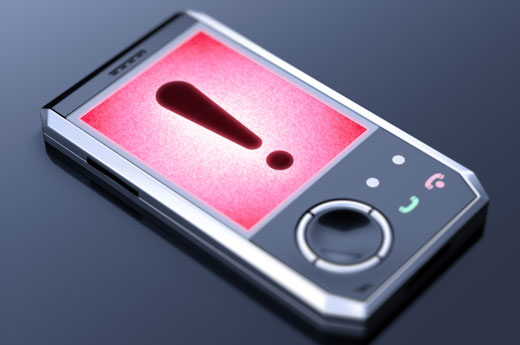
by guest blogger Isaac Eliaz, MD, MS, LAc, integrative medicine pioneer
Despite a long and contentious debate, published research is increasingly pointing to cellphone use as a risk to your health. The level and types of risk remain uncertain, but considering that four billion people today rely on cellphone for daily communication, any risk is unsettling.
Among the most recent studies casting doubt on cellphone safety is one published in the journal Antioxidants & Redox Signaling. The study arose from concerns that the very low levels of radiation emitted by cellphone may damage tissues of the head and neck, since the phones are typically held close to the ear for long periods of time. Researchers in Israel studied the saliva of 20 people who had been using cellphone from 8 to 15 years with an average time on the phone of 29.6 hours per month. The researchers focused on changes in saliva associated with oxidative damage to human cells. (Oxidative damage can occur when unstable molecules such as free radicals wreak havoc on cells, tissues, and DNA.) The results showed that cellphone users had a significantly higher increase in salivary markers for oxidative damage, compared with a group of deaf people who don't use cellphone.
This study adds to a growing body of evidence that cellphone use is capable of damaging human cells. Studies published in the journal Oral Surgery, Oral Medicine, Oral Pathology, Oral Radiology, and Endodontology and in the journal Oral Diseases found that mobile phones can directly damage cells in the salivary glands, causing the glands to become overstimulated.
Other recent reports provide insight into what may actually be happening to human cells affected by mobile phone radiation. Research published in the Journal of Neuro-Oncology found that cellphone radiation may cause DNA damage and alter genes in brain cells. Additionally, a study of male volunteers reported in the International Journal of Basic and Applied Sciences showed that long-term use of cellphone can cause DNA damage and chromosomal instability in cells of the oral cavity and lymphatic system that could increase the risk of cancer.
The body of objective scientific research shows that wireless phone radiation penetrates the skull, affects blood flow, alters temperature and brain glucose metabolism, and may weaken the brain's protective blood-brain barrier. Still, the debate over potentially harmful effects of long-term cellphone use is likely to rage on for years. The wireless industry and its lobbying groups provide plenty of funding for studies that find no link to ill health effects or are at least inconclusive. Health activists who carry the findings of studies like these too far also provide fuel for the critics. But while the public waits for definitive answers, we can take protective measures with an antioxidant-rich diet and extra supplementation to prevent or reduce possible risks linked to cellphone. The same measures may reduce health risks associated with many other forms of oxidative damage.
- Sea buckthorn, which helps protect against radiation damage and provide antioxidant support
- Rosemary extract, which contains compounds that fight radiation damage and provide antioxidant support
- Kelp, which contains sodium alginates to help remove radiation from the body
- Honokiol (magnolia bark extract), a powerful antioxidant and cell protector
- Medicinal mushrooms, particularly Reishi and Cordyceps, which help protect tissues from oxidative stress and inflammation, while detoxifying the body. Medicinal mushrooms are used to prevent tissue damage from radiation therapy in oncology treatments.
- Modified citrus pectin, which safely removes radioactive particles and heavy metals, combats inflammation, and blocks abnormal cellular growth
Experts also recommend reducing cellphone radiation exposure with your speaker phone function or using a headset with an air tube leading to the ear, such as this one. You can also limit the length of your conversation or use texting. When your cell phone is not being used, it is best to keep it away from direct contact with your body, especially near highly sensitive organs and tissues, such as the genital area, breasts, head, and thyroid.
Risk or no risk, cell phones are becoming the mainstay of personal communications, and as new uses for personal devices increase, so will our exposure to radiation levels. No matter which side of the debate a person chooses in our high-tech society, an ounce of prevention will always be worth a pound of cure.
 Isaac Eliaz, MD, MS, LAc, integrates Western medicine with his extensive knowledge of traditional Chinese, Tibetan, Ayurvedic, homeopathic, and complementary medical systems. With more than 25 years of clinical experience and research, Dr. Eliaz has a unique holistic approach to the relationship between health and disease, immune enhancement, detoxification, and cancer prevention and treatment. For more information about his work, visit dreliaz.org.
Isaac Eliaz, MD, MS, LAc, integrates Western medicine with his extensive knowledge of traditional Chinese, Tibetan, Ayurvedic, homeopathic, and complementary medical systems. With more than 25 years of clinical experience and research, Dr. Eliaz has a unique holistic approach to the relationship between health and disease, immune enhancement, detoxification, and cancer prevention and treatment. For more information about his work, visit dreliaz.org.
For more from Maria Rodale, visit www.mariasfarmcountrykitchen.com.